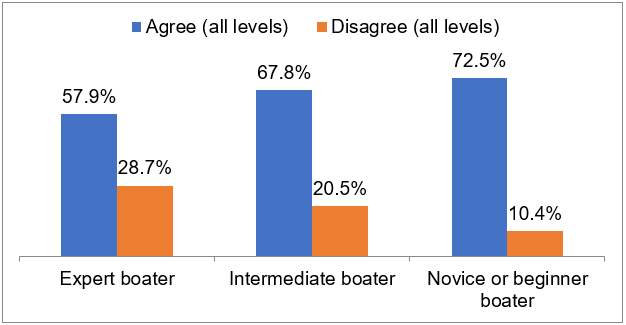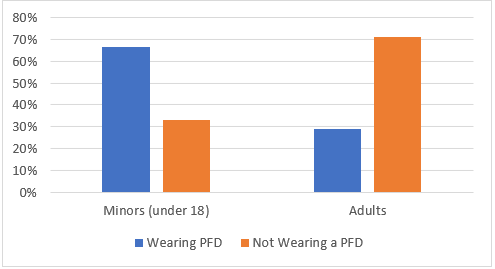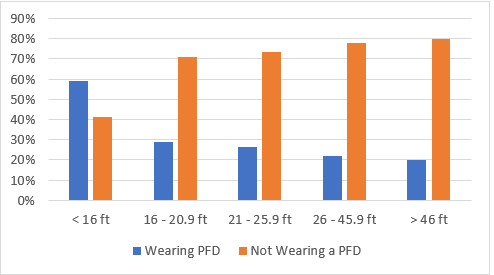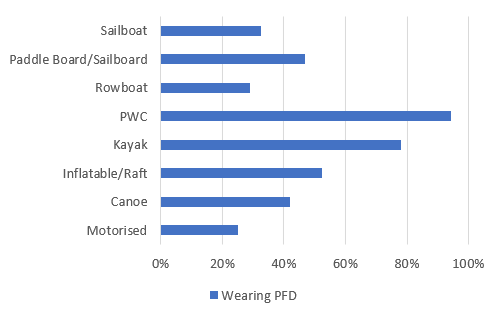Background
Recreational boating is a popular activity in Canada, with as many as 12.4 million Canadians taking part in boating activities each year. Unfortunately, the popularity of this activity also results in a large number of safety incidents occurring. Canada averages 111 recreational boating fatalities each year, the highest number of deaths within the marine sector.
Not using a personal flotation device (PFD) or lifejacket is a leading cause of death among recreational boaters, accounting for 89% of all fatalities. While these numbers fluctuate from year to year, they have not shown any consistent downward trends.
Transport Canada’s Small Vessel Regulations (the Regulations) require that an approved PFD or lifejacket of an appropriate size be carried for each person on board a recreational vessel, but the Regulations do not require them to be worn, except in limited circumstances. Public consultations on mandatory wear for recreational boaters were last held in 2009-2010 at the national meeting of the Canadian Marine Advisory Council, where there was no consensus among stakeholders in terms of introducing regulatory requirements for wearing a PFD or lifejacket.
Internationally, other maritime jurisdictions such as Ireland, Australia, and New Zealand, have mandatory wear requirements targeted for specific circumstances such as operator/guest age, the size or type of vessel being used, and in situations of heightened risk. Available data shows these requirements have been largely effective in decreasing fatalities, particularly when targeted toward situations which are proven to be dangerous for boaters. For example, when Australia’s state of Victoria implemented mandatory wear for all boaters under the age of 10, anyone on board a power boat less than 5 metres in length, and anyone using a human-powered vessel, the drowning rate for that state dropped by 67% over five years.
Behavioural Scientist Intervention
Work to re-examine the issue of the mandatory wearing of personal flotation devices (PFDs)/lifejackets on board recreational vessels began in 2018, in response to increased attention from stakeholders and the public, as well as consistently high fatality rates among recreational boaters.
In 2019, Transport Canada began working with a behavioural scientist from the Privy Council Office to conduct a research project on the topic of mandatory wear. This project was aimed at examining PFD/lifejacket use, identifying which demographics most often do or do not wear PFDs/lifejackets in certain circumstances, while also exploring the motivations for or against their use among recreational boaters. The project consisted of an online survey to assess PFD and lifejacket perceptions among recreational boaters (completed in 2020), and on-site observations by Boating Safety Officers (completed in 2021) to record the wearing of PFDs and lifejackets among different demographics, while measuring the impact of various factors (weather, temperature, vessel type, etc.) on wear rates.
Online Survey
The online survey received approximately 2,000 responses over a four-month period, with 47.8% of respondents reporting they always wear a PFD or lifejacket while boating. The results varied widely depending on the respondents reported skill level and the type of vessel they operated. However, participants across all skill levels generally agreed that not wearing some form of flotation device while boating was irresponsible.
PFD/lifejacket use by skill level
“I wear a PFD/lifejacket all the time”

Perception of boaters by skill level on whether not wearing a PFD/lifejacket is irresponsible

On-site Observations
On-site observations were conducted during the 2021 boating season at different bodies of water. During these observations, Boating Safety Officers visited 10 marinas across the country on a biweekly basis to observe and record PFD/lifejacket wear rates among recreational boaters on different vessel types, engaged in different activities. The observers used a variety of tools to track weather conditions which may have impacted wear rates (wind speed, water temperature, etc.) and recorded any observed changes these conditions had on behaviour.
Results from these observations were compared with the online survey, to develop a situational portrait of Canadians’ use of PFDs/lifejackets. Key takeaways found that:
- 34% of boaters recorded during the observations wore a PFD or lifejacket;
- PFD/lifejacket wear rates for minors (under the age of 18) were nearly double that of adults (67% for youth vs. 29% for adults);
- Children 6-12 years of age were found to have the highest wear rates (75%);
- Women were found to have slightly higher wear rates than men (38% vs. 31%);
- Wear rates varied widely across vessel types but were found to be higher onboard small vessels as opposed to larger vessels;
- Results for human-powered vessels ranged widely, with high wear rates for boaters using kayaks (78%), but much lower rates for those using canoes (41%); and
- Passengers were found to be much more likely (46x) to wear a PFD/lifejacket when the operator was wearing one.
General Wear Rates

Wear Rates by Boater Age

Wear Rates by Vessel Size

Wear Rates by Vessel Type

Canada Safe Boating Council Aerial Observations
Concurrently with Transport Canada’s summer 2021 observations, the Canadian Safe Boating Council partnered with the Ontario Provincial Police to observe PFD/lifejacket use among recreational boaters on multiple lakes in southern Ontario. Unlike Transport Canada’s observations, which were conducted by observers using binoculars from the shoreline, these observations used aircraft to observe boaters operating further from shore, often in relative isolation.
Despite the distance from shore, results from this initiative mirrored those collected by Transport Canada, with the aerial observations recording a 33% wear rate among boaters. Further, these observations recorded similar findings regarding high wear rates among youth and on which sizes/types of vessels boaters were less likely to be found wearing a PFD or lifejacket.
Recreational Boating Fatalities Report
In 2021, through funding provided by Transport Canada’s Boating Safety Contribution Program, the Drowning Prevention Research Centre Canada produced a report tracking recreational boating-related fatalities in Canada from 2008 to 2017. This data was drawn from reports from coroners’ offices across the country and outlined, among other details, victims’ demographics, the size and type of vessel they were operating at the time of the incident, and whether or not they were wearing a PFD or lifejacket.
Key takeaways from this report found that:
- The majority of individuals who died as a result of a recreational boating-related incident were not wearing a PFD or lifejacket at the time of the incident;
- Deaths primarily occurred among adults, the majority of whom were male;
- Most recreational boating-related deaths occurred during powerboat use. Canoes were the next most common vessel type used prior to a fatality; and
- The most common incident resulting in a fatality was the vessel capsizing, followed by a person falling or being thrown overboard.